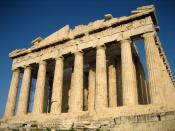Greek population began to unfurl by the year 6000 BC. This immense concentration of people was due to Siberian tribes searching for new farming land in central Asia. By the year 1000 BC, Greek culture began emerge after numerous waves of migration. By the year 500 BC this Greek culture had reached a point of classical perfection which would, in turn, influence many other societies throughout history. Some anthropologists may say that Greek culture and art represent the "true" beginnings of Western civilization.
Throughout history, Greek civilization and culture have evolved, as does any other culture. But Greek civilization can be divided into three, definite and unique periods. Beginning with the Minoan Period, this lasted from 3000 BC to 1150 BC. The Minoan people were of non-Greek descent that inhabited the island of Crete. These people produced a highly sophisticated society which was influenced by the Egyptians and Phoenicians.
The next period of Greek development is dubbed the Mycenaean Period; this lasted from 1650 BC to 1000 BC.
Due to the prowess that these people attained, the Minoan society was soon over taken. The Mycenaean people established large cites throughout ancient Greece, one of which was the city of Athens. Athens today is still one of the larger cities in Greece. The history of the Mycenaean people is rather vague. Some believe that these people were more involved with myths and legends, rather than those spoke of by the poet Homer. It is during this period that the Trojan wars occurred (1200 BC). It is believed that the Mycenaean people attacked the people of Troy because of commercial reasons.
The third period of Greek civilization is known as the Doric Period. This period lasted from 1000 BC to 800 BC. During this short span of time, the Dorian speaking Greeks...


